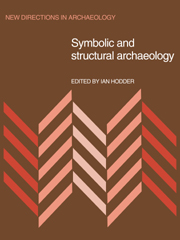Book contents
- Frontmatter
- Contents
- List of contributors
- Preface
- Part one The development of theory
- Part two The search for models
- Part three Application: the analysis of archaeological materials
- 11 Boundedness in art and society
- 12 Ideology, symbolic power and ritual communication: a reinterpretation of Neolithic mortuary practices
- 13 Ideology, change and the European Early Bronze Age
- 14 Sequences of structural change in the Dutch Neolithic
- Part four Commentary
- Index
14 - Sequences of structural change in the Dutch Neolithic
Published online by Cambridge University Press: 27 February 2010
- Frontmatter
- Contents
- List of contributors
- Preface
- Part one The development of theory
- Part two The search for models
- Part three Application: the analysis of archaeological materials
- 11 Boundedness in art and society
- 12 Ideology, symbolic power and ritual communication: a reinterpretation of Neolithic mortuary practices
- 13 Ideology, change and the European Early Bronze Age
- 14 Sequences of structural change in the Dutch Neolithic
- Part four Commentary
- Index
Summary
In this chapter the evidence of pottery decoration and shape, axe decoration, burial, settlement and economy is linked in comparable sequences of change which can be identified on both the North European plain and on the adjacent loess soils. In the first phase, found only on the loess, individual units within social groups can remain in close proximity, the social groups gradually expanding outwards. Pottery, burial and settlement show little concern with contrasts and oppositions. In the second phase, seen in the later LBK and Rossen and early TRB, there is outwards expansion, the spatial coherence of local groups is complicated by shorter term, more dispersed settlement and there is perhaps evidence of new forms of social dominance. There is a concern with oppositions in the pot decoration, a large number of vessel forms and large amounts of decoration, complex burial ritual in the TRB, and nucleated ditched villages in the Rossen. The material culture helps to form and legitimate the social categories in a period of increasing contradictions. In the third phase, the PFB, there is less emphasis on oppositions and categorisation in material culture and the various classes of evidence suggest a transformation of earlier tensions. The historical nature of the enquiry is stressed and the appropriate use of symbols such as shapes of burial mounds is outlined.
The setting
The physical environment of the Netherlands and adjacent areas can be divided into three major zones (fig. 1). The first area is the coastal sedimentation of the Rhine–Maas (Meuse) delta. Up to about 3000 BC the coastline retreated inwards, while after this date it began moving out again.
- Type
- Chapter
- Information
- Symbolic and Structural Archaeology , pp. 162 - 178Publisher: Cambridge University PressPrint publication year: 1982
- 28
- Cited by



